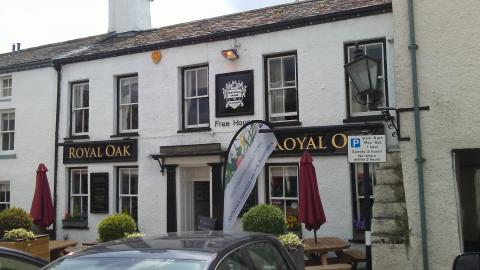The Royal Oak

In many English towns and villages there’s a public house by the name of The Royal Oak. There’s one in Clitheroe just six miles from our chapel and the one pictured I saw in Cartmell. It is not merely a reference to the quintessential Englishness of Oaks, nor its primacy among the other woodland trees. Rather, it alludes to a distinctive historical event on 6th September 1651. Charles Stuart, son of the executed king, had invaded England at the head of a Scottish army. At Worcester he and his Scots were roundly defeated by Cromwell and he hid at Boscobel House. Advised by the ironically named Captain Careless, he removed himself to an oak tree in the grounds, judging the house to be unsafe. He later reminisced to Samuel Pepys that a Parliamentarian search party passed beneath him, unaware that their quarry was but ten feet above their heads. When it was safe, he fled to France dressed as a woodsman. The oak itself is no longer there, having succumbed to seventeenth- and eighteenth-century tourists’ ambitions to take home branches and twigs as mementos. An oak from one of the original’s acorns now stands in the spot and can still be visited.
It is an interesting episode in our history, and publicans have sought to assure punters of their patriotic credentials by commemorating it in their establishments’ name. There’s a contrast here between an English king and the King of Kings. The New Testament writers sometimes refer to the cross upon which Jesus died as ‘the tree’:
And we are witnesses of all things which He did both in the land of the Jews and in Jerusalem, whom they killed by hanging on a tree. -Acts 10:39
Usage of ‘tree’ might have been because they were recoiling at the horrors of crucifixion -they had seen the real thing, not having to rely on sanitised Sunday School books. Secondly, it is a reference to the Old Testament’s cursing of those who die on the tree, linking Christ’s mode of death with His bearing the Law’s curse. Whereas Charles Stuart hid in a tree to keep himself safe and his whereabouts discreet, the King of Kings was hung on a tree in a most public and shameful manner. Not only was His naked and bleeding body derided by men, it was beheld and observed by the entire population of angelic beings. Doubtless, some of them jeered and mocked, while others pondered the incredible meaning of life’s Source expiring is so horrific a manner.
I know not the kind nor quality of the wood used for Calvary’s cross. I imagine it to have been the cheapest, coarsest timber available. Like Boscobel’s Oak, the original is long gone, but it is the most royal and powerful of woods ever seen, for it is the means by which we shameful sinners are brought back to God; Christ hung exposed and vulnerable so we who believe might be covered and clothed in robes of white.
- Log in to post comments


 Sunday Worship 10.45am & 6.00pm
Sunday Worship 10.45am & 6.00pm